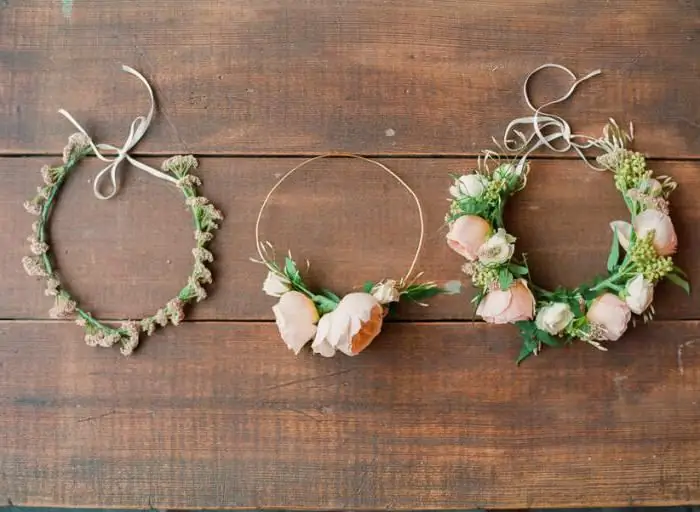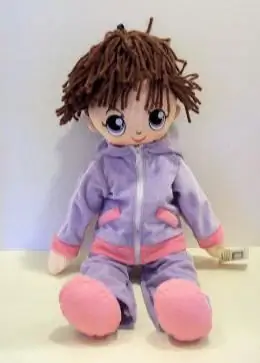
Inhaltsverzeichnis:
- Autor Sierra Becker [email protected].
- Public 2024-02-26 04:43.
- Zuletzt bearbeitet 2025-01-22 22:11.
Perlenblumen sind ein tolles Weihnachtsgeschenk. Alle frischen Blumen sind schön und entzückend. Absolut jeder trägt seine bezaubernde Aura und Schönheit in sich. Wahrscheinlich mögen viele Menschen Flieder, Rosen, Gänseblümchen, Callas oder andere Blumen. Allerdings sind sie alle kurzlebig. Wenn ein Ereignis oder eine bestimmte Person für Sie relevant ist, raten wir Ihnen zu einem Geschenk, das Sie länger in Erinnerung behält.
Callas sind anmutige und sehr schöne Blumen. Aber wie andere Pflanzen verwelken Calla-Lilien schnell. In diesem Artikel schlagen wir vor, im Detail zu studieren und zu lernen, wie man Calla-Perlen richtig webt.

Die Lektion ist ganz einfach und spannend. Ihre Aufmerksamkeit wird auf mehrere Optionen zum Erstellen von Callas aus Perlen gelenkt. Anschließend hilft dies bei der Bildung eines originellen und schönen Blumenstraußes.
Lassen Sie uns zur Verdeutlichung die Besonderheiten des Webens von Blumen in der vorgeschlagenen Meisterklasse (MK) Calla-Lilien aus rosa Perlen betrachten. Machen wir uns an die Arbeit.
Materialien und Werkzeuge
Bevor du mit dem Weben von Callas beginnst, musst du Folgendes vorbereitenMaterialien:
- rosa Perlen;
- hellrosa Perlen und Glasperlen;
- braune Perlen;
- Silberdraht - 0,3 mm;
- Draht mit 1 mm Durchmesser;
- grüne Fäden und Blumenband.
Blassrosa Callas mit Perlen: Meisterklasse
Worauf sollte ich mich vorbereiten? Sie müssen ein wenig Zeit aufwenden und eine wirklich luxuriöse Blume kreieren, die eine perlenbesetzte Calla ist. Das Webmuster ist recht einfach und wird Ihnen helfen, diesen akribischen Prozess zu verstehen. Grundlage ist die Anwendung der französischen Perlenstickerei.

Der Ablauf ist wie folgt:
- Um die erste Reihe zu erstellen, fädeln Sie in der folgenden Reihenfolge auf: sieben rosa Perlen, ein zartrosa Signalhorn und neun blassrosa Perlen.
- Beim weiteren Weben müssen Sie die Reihe der rosa Perlen vergrößern und die Reihe der blassrosa verkleinern.
- Ändere die Anzahl der aufgereihten Perlen nach Belieben so, dass die Abstände in den Reihen minimal sind. Ein ähnliches Calla-Blütenblatt wird aus drei Perlenreihen gebildet, die sich in der mittleren Reihe befinden.
- Als nächstes kommen sechs Ebenen - zwei auf jeder Seite. Die letzte Reihe, die sich an der Basis des Blütenblatts befindet, enthält eine Ebene. Es besteht aus rosa Perlen.
- Die nächste Seite des Blütenblattes ist die gleiche wie die erste.
Bilde eine Callaknospe
- Nachdem die Bildung des Blütenblatts abgeschlossen ist, wird es benötigtannähen, um eine stabilere Form zu fixieren. Dann sollten Sie ein Staubblatt in den Kern der Calla einführen und die Blume sicher am Drahtstab befestigen.
- Danach mit Blumenklebeband umwickeln. Das Klebeband kann durch mit Klebstoff getränkte grüne Fäden ersetzt werden. Das Fass muss sorgfältig eingewickelt werden.
- Um ein Staubblatt zu bilden, musst du siebenundzwanzig braune Perlen aneinanderreihen. F alten Sie den Draht mit Perlen in zwei Hälften und drehen Sie ihn zusammen. Als Ergebnis erh alten Sie vollwertige Callas aus Perlen.
Blätter weben
Um perlenbesetzte Calla-Blätter herzustellen, müssen Sie einige Materialien vorbereiten:
- grüne Perlen;
- Draht passend zur Farbe der Perlen (0,3 mm);
- Draht mit einem Durchmesser von einem Millimeter;
- grünes Blumenband.
Bead Callas haben längliche Blätter. Dementsprechend müssen Sie die Technik des parallelen Webens anwenden. Ein Blatt besteht im Wesentlichen aus zwei zusammengenähten Hälften.

Bitte beachten Sie, dass die unteren drei Reihen Ihres Papiers nicht zusammengeheftet werden müssen. Dies geschieht so, dass Ihr Perlenbogen am Ende so gut wie möglich das lebendige Original widerspiegelt.
Danach musst du einen Stab mit einem Durchmesser von einem Millimeter nehmen und ihn mit grünem Klebeband umwickeln. Das resultierende Werkstück muss mit dem grünen Draht auf der Rückseite des Blechs befestigt werden. Mache auf ähnliche Weise zwei weitere ähnliche Blätter.

Beaded Callas findenEleganz und Ästhetik, wenn sie zum Beispiel in einer schönen Vase platziert werden. Wenn Sie möchten, können Sie eine Gipsmischung herstellen und Ihre Blume in einem Blumentopf befestigen.
Callas mit weißen Perlen: zweite Version
Um eine andere Version des Blumenarrangements zu bilden, benötigen Sie:
- transparente oder helle Perlen;
- gelbe Perlen;
- silberne oder grüne Drähte mit einem Durchmesser von 0,3 mm;
- Schere.
Fortschritte und einige Empfehlungen
- Beginnen Sie mit perlenbesetzten Calla-Blütenblättern. Dazu müssen Sie ein achtzig Zentimeter langes Stück Draht vorbereiten. Dann machen Sie eine kleine Schleife an seinem Ende. Als nächstes müssen Sie drei Zentimeter weiße Perlen auffädeln. Machen Sie eine weitere zusätzliche obere Schleife.
- Danach sollten Sie das Gewebe umdrehen und weiße Perlen auf das Arbeitsende des Drahtes auffädeln. Drehe die ursprüngliche Reihe um.
- Als nächstes musst du dein Gewebe wieder umdrehen und die gleiche Anzahl an Perlen auffädeln. Machen Sie die nächste Drehung um die Achse.
- Fahren wir mit der Erstellung der Seiten des Blütenblatts fort.

Dazu musst du weiße Perlen auf das Arbeitsende des Drahtes auffädeln und fixieren. Zähle gleichzeitig die drei Perlen, die oben sind.
- Als nächstes die Perlen wieder auffädeln und die Linie nach unten ziehen. Machen Sie eine Schleife und gehen Sie nach oben, um die nächsten Perlen aufzufädeln. Drei Perlen zählen und auf der anderen Seite befestigen. Damit haben Sie die Erstellung des ersten Calla-Blütenblatts abgeschlossen.
- Als Nächstes müssen Sie dasselbe tun. Zählen Sie fünf Perlen ab. Es ist notwendig, nach unten zu gehen und eine Kurve zu machen, um die nächste Seite hinaufzugehen. Webe weiter und zähle dabei sechs und acht Perlen.
- Insgesamt musst du sechs Mal Vertiefungen in die Perlen machen. Wenn das Blütenblatt geformt ist, müssen Sie es begradigen und ihm die richtige Form geben.
- Zur besseren Fixierung müssen Sie das Blütenblatt von außen mit einem Draht annähen. Mit dem Draht kannst du der Calla die gewünschte Form geben.
- Machen Sie einen Stößel aus einer gelben Schicht. Sie sollten auf die gleiche Weise wie in der ersten beschriebenen Meisterklasse zehn Zentimeter Perlen sammeln.
- Den fertigen Kern in die Blüte stecken und mit Draht am Stiel befestigen.

Um das Blumenarrangement aus weißen Callas zu vervollständigen, können Sie Perlenzweige auf grünem Draht aus farblosen Perlen weben.

Bilden Sie am Ende aus der resultierenden Perlenreihe Schlaufen über die gesamte Länge des Segments.
Schlussfolgerung
Beading ist ein ziemlich aufregender Prozess, aber nicht alle Arbeiten liegen in der Macht von Anfängern. Was das Weben von Callas aus Perlen betrifft, so liegt die Besonderheit dieser Arbeit nur in der Aufmerksamkeit und dem Befolgen der Reihenfolge.
Die Durchführung eigener Experimente ist zulässig, wenn Sie den Mechanismus der Perlenstickerei eines bestimmten Produkts kennen. Versuchen Sie daher, wenn Sie ein Anfänger sind, zuerst die Prinzipien und Grundlagen des Perlenstickens zu lernen.
Empfohlen:
So machen Sie "Live"-Fotos: eine Schritt-für-Schritt-Anleitung, eine Programmübersicht und Empfehlungen

Vor nicht allzu langer Zeit wurden Instagram und andere soziale Netzwerke mit einem neuen Modetrend überschwemmt - "Live"-Fotos. Wie mache ich ein Live-Foto? Im Moment wurden viele verschiedene Programme entwickelt, mit denen Sie den gewünschten Effekt erzielen können
So bauen Sie ein Fototelefon zum Selbermachen: eine Meisterklasse, interessante Ideen und Empfehlungen

Wenn Sie sich für Food- oder Produktfotografie interessieren, wissen Sie ganz genau, dass einer der wichtigsten Bestandteile einer guten Aufnahme der richtige und schöne Hintergrund ist. Es ist gut, wenn das Studio des Fotografen bereits originale strukturierte Oberflächen hat, und wenn nicht, dann wie man ein Fototelefon zum Selbermachen herstellt. Original-Fotophone können unabhängig voneinander hergestellt werden, während die Bargeldkosten minimal sind und das Aufbewahren und Bewegen ganz einfach ist
Schwertlilien aus Wellpappe: eine Meisterklasse und Empfehlungen

Diese schöne Blume ist im Garten, Gewächshaus und im Freien zu sehen. Lassen Sie uns gemeinsam versuchen, Iris aus Wellpappe herzustellen und das ganze Jahr über ihre Schönheit zu genießen. Die im Artikel vorgeschlagene Meisterklasse hilft Ihnen, diesen einfachen und interessanten Prozess zu verstehen
Beaded Valentines: eine Meisterklasse und ein Webmuster

Jeder liebt die Feiertage, besonders wenn sie viel Romantik und Wärme enth alten. Der Valentinstag ist ein Tag der Liebe und eine Zeit der Offenbarung. Der Tradition nach tauschen Verliebte an diesem Feiertag kleine Notizen mit Geständnissen in Form von Herzen aus - Valentinsgrüßen
Wie man mit eigenen Händen Haare für eine Puppe macht: eine Meisterklasse. Wie man Haare an eine Puppe näht

Dieser Artikel beschreibt alle möglichen Ideen und Möglichkeiten, um Haare für Textilpuppen und Puppen zu kreieren, die ihr Aussehen verloren haben. Haare für eine Puppe selbst zu machen ist viel einfacher als es auf den ersten Blick scheint, eine detaillierte Beschreibung hilft Ihnen dabei, dies sicherzustellen
